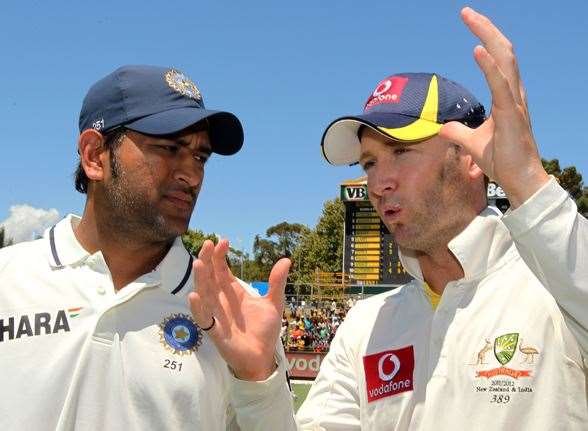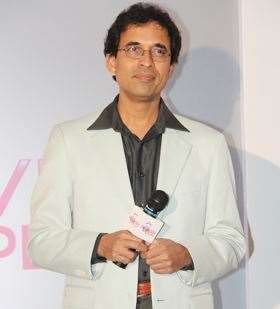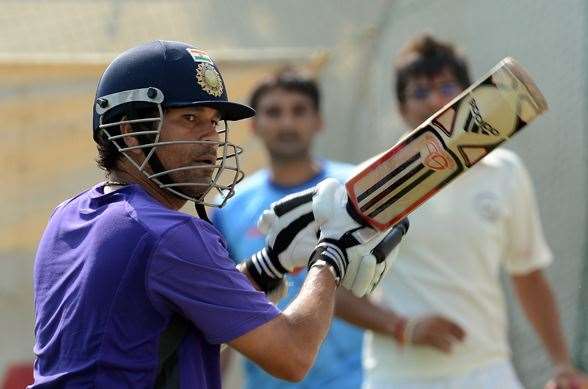We have Richie; India has Harsha Bhogle. He’s the voice of the game in that cricket-mad nation, and has been acclaimed as the world’s favourite commentator.
We have Richie; India has Harsha Bhogle. He’s the voice of the game in that cricket-mad nation, and has been acclaimed as the world’s favourite commentator. His unconventional path to the commentary box began at 19, on Indian radio, having previously studied chemical engineering and worked in an advertising firm. He’s worked on radio in Australia during India’s tours here, and can be found on a multitude of other outlets around the world, including as a columnist for ESPN Cricinfo.
Bhogle follows in the grand tradition of professional broadcasters in the box, bringing a wonderfully lyric quality to his commentary. But as he proved on India’s last Test series in Australia, there’s fun to be had – along with Kerry O’Keefe, Bhogle stole the show during the Sydney Test when he dared the cackling ex-spinner to eat a Naga chilli, the hottest pepper on the planet. The ensuing dialogue was a radio classic, as listeners around the SCG turned their attention from Michael Clarke’s superlative batting to start a slow clap for O’Keefe.
Inside Sport caught up with Bhogle to get his insight on the upcoming Border-Gavaskar Trophy series, why it’s a crucial upcoming season for IPL, and India’s role in figuring out the shape of cricket’s future.
How do you sum up the public mood around the Indian team coming into the Tests against Australia? Both sides have had recent series defeats at home …
Slightly more positive after winning the one-dayers against England. But in general, after losing the Test matches to England – which was an unexpected result, given how badly England have played in India over the years, and the fact that England’s spinners out-spun India’s spinners, that was the most disappointing aspect of that series – there was an air of despondency and gloom around Indian cricket. It was lifted partly by beating England (in the one-day series), but the more knowledgeable among us know that it wasn’t the best England side; England has lost 19 of their last 22 in India.
Is there a sense, though, that the English side is better than what the Australian visitors will be?
Yes, largely because they had two very good spinners, and a couple of batsmen of pedigree. I think the feeling about Australia coming to India is that, while Michael Clarke remains the fulcrum and is a very widely respected batsman and captain in this part of the world, the chop and change at the top of the order in Australia gives India some hope. One of the worries in India is its bowling hasn’t been as good, especially the spinners. There’s muted optimism about playing against Australia, but definitely aware that this Australian team is not as good, or doesn’t seem as good, as England does.
Australia has always found it tough to play and win in India, even with the great teams of the Taylor and Waugh years. Does that give the Indians an added confidence – that home is a bit of a fortress?
Most of the time, winning in India was difficult because you had Anil Kumble in the side. Kumble was a great bowler in Indian conditions. Harbhajan Singh used to be around. And you had the likes of Dravid, Laxman, Tendulkar, Sehwag, Ganguly – so playing in India was not easy, especially with all these people around. But Kumble’s retired three or four years now, Dravid’s gone, Ganguly’s gone, Laxman’s gone, Tendulkar’s coming to the end. It’s a very different Indian side to the one that made it difficult to win on the subcontinent. People coming to India now look at this side and think, “Hang on, the people who made it difficult are no longer there, we’ve got a chance here.”
That seems just as true for Australia – there’s a sense of transition in both sides.
That’s fair, and the transition will only grow as we go along. We don’t know how much Sehwag has left. Gambhir is struggling a little bit. So this transition that’s taking place in India, that’s seen the arrival of Pujara, that’s seen the arrival of Kohli, that’s seen Ashwin make a great debut but has flattened off a little at the moment, that churn will become stronger as we go along. There’s an awareness in India at the moment that Zaheer Khan may not play too much more or has played his last Test, who knows? So we’re looking at younger quick bowlers, spinners not coming through. We’re only just starting on that period of transition, not coming to the end of it.
What’s the state of Dhoni’s position – any danger, or as you wrote, perhaps he’ll give up the captaincy in one of the forms of the game?
I don’t know, because Dhoni has a lot of support from the selectors. There’s also an awareness that there isn’t another captain in sight yet. They were grooming Kohli at some point, but he’s gone through a bit of a rough patch with the bat himself. So there isn’t really an alternative to Dhoni as captain, so I don’t see his position as under threat at all at the moment. I do see a greater pressure on him to deliver, especially in home conditions.
 Skippers MS Dhoni and MIchale Clarke have the task of rebuilding their Test sides in their hands. Image: Getty Images
Skippers MS Dhoni and MIchale Clarke have the task of rebuilding their Test sides in their hands. Image: Getty ImagesWe’ve had a summer here in which we waved goodbye to Ponting and Hussey, and the feeling of valedictory was in the air. Tendulkar may be another level above that – what’s the feeling around his situation?
No one knows how much longer he wants to play. But I think it’s apparent, and Tendulkar knows it very well too, that he’s not looking like the cricketer he was. He struggled a great deal against England, and as happens when you’re going through a bad patch, you tend to get the best ball of the day delivered to you. But he’s gone back and made some runs in Ranji Trophy cricket.
The feeling at the moment is that this might well be the end, that this might be the swansong against Australia. He keeps his cards very close to his chest. There’s still an enormous amount of goodwill for him, but people are starting to say, “Hang on, how much longer?” Which was pretty much the feeling that Australia had with Ponting.
Is there a natural endpoint for Tendulkar? We thought that maybe Ponting and Hussey were looking toward the Ashes series this year, so maybe it came as a bit of a surprise. Is there a series or event that Tendulkar would be thinking about?
After this series against Australia, India doesn’t play Test matches until November in South Africa. Tendulkar will be 40 years and six months old. I don’t know whether this series against Australia will be a natural endpoint (for Tendulkar), but most people would want to finish in home conditions, in front of your home crowds. And then Tendulkar’s got six months later to go to South Africa? I don’t know whether he fancies himself playing in South Africa, because straight after that, there’s a series in England in June, that’s five Tests, then India comes to Australia. I don’t know if he fancies playing that long, so my feeling is, this is a series he will take Test match by Test match.
The man-on-the-street view in Australia is that India values limited-over cricket over Tests. How important is Test match cricket to India and, more specifically, the Border-Gavaskar compared to its other international exchanges?
To be fair, India played a series at home against New Zealand, played a series against England, and then Australia. That’s ten, 11 Test matches in a home season. Then away Test matches. That’s a lot of Test match cricket. The Ranji Trophy matches are now five days long. There’s a feeling that we need to be a better Test side, there’s no doubt at all. But there’s a lot of T20 cricket, not international, but the IPL, Champions League. One of the challenges for Indian cricket at the moment is trying to balance everything, which is leading to too much cricket from my point of view.
Which leads to my next question: the great row of the summer here is player rotation, because of the load of cricket. What’s your view on that?
Cricket depends for its sustenance on television, and it’s commercially driven. In a country like India, for example, television has to be commercially driven because we don’t have a lot of subscription revenue. And one-day cricket is ideal for that, so they have to keep one-day cricket alive. India needs to have one-day cricket alive, feels the need to keep Test cricket alive and T20 is the new kid on the block that you can’t do without. At the moment, India is a bit like a child that wants all three toys.
You’ve written about the need for Indian cricket to have a review – what’s the major issue that would need to be addressed?
I thought Indian cricket needed to place more emphasis on win and loss, rather than profit and loss. Eventually, a country should be determined by how many games it wins and loses, because Indian cricket will always be profitable. It might go through a year of less profit and a year of more profit, but Indian cricket will always be largely profitable.
But Indian cricket now needs to assume a leadership role on the field, and we’re not getting match-winners coming through with the ball. We’re not getting the spinners who’ll run through opposition sides at home. We’ve got a lot of promising, young fast bowlers, although they’re some distance from playing everywhere. We need to have a review: how much domestic cricket do we play? Is our domestic cricket throwing up the best players or not? When Australia was at their peak, it was because their domestic structure was the strongest. South Africa is looking very good because the franchises are still strong in South African first-class cricket. That was my thesis.
IPL: is this a critical year?
This year is, because we’ve seen five editions of the IPL. First edition was a huge success, and number two, because of the elections and the problem with security, it had to move to South Africa. Moving to South Africa made it a bigger global brand, but the sponsors wanted it back in India, and IPL3 was a fantastic success. Four and five, the viewership has dipped, most matches are still sell-outs, but viewership has dipped. If you talk to people who buy advertising (time), they’re saying this was inevitable. But it’s still at a point they’re happy with, because there’s no commercial property that delivers you fairly standard ratings over two months. The ratings go a little up when Mumbai plays, or Chennai, or Kolkata, but largely, the ratings, there’s not much variation.
IPL6 will be a massive test, because if the ratings drop further, then people will start to get worried. If the crowds stay away, because it’s been a very crowded domestic season, there will be cause to worry. Personally, I’m a big fan of IPL, but I’m looking at season six to get a lot of answers. To be fair, they’ve just signed a colossal sponsorship deal – it surprised all of us, I think it surprised the BCCI as well.
On the field, is it approaching a level of stability? IPL has always carried this freight of being a symbol of modernity for India – is it coming around to becoming a sporting competition that followers of the game value?
If IPL6 is a good year, then IPL will have taken giant strides towards becoming a long-term, sustainable brand. It already feels that way, but it will have taken giant strides. In the past, IPL has tended to be followed by international tours where India has not done well. So part of the criticism against the IPL is that it happens where India doesn’t do well. There isn’t a lot of international cricket after (IPL this year) … The key is now for IPL to become a very high-standard cricketing activity as well.
How does IPL relate to international cricket? It effectively is international cricket in the way that UEFA Champions League is international football. Is IPL destined to be the rung below, or can it be an effective complement?
Cricket is in a peculiar situation because in football, traditionally, players played for clubs seven months, then turned out for their country. When you think of Ronaldo, you think Manchester United and Real Madrid. You don’t immediately think Portugal. When you think Messi, you don’t think Argentina, you think Barcelona first. But in cricket, it’s the other way around. You say Michael Hussey, you think Australia first, not Chennai Super Kings or Western Australia first. Cricket’s tradition has always been playing for the country, and it’s a massive tradition to change. The IPL and the Big Bash is very young to international cricket, where as in football, club sport is almost as old as international sport.
So it’s going to be very challenging. What the IPL has achieved in five years has been remarkable, to create a club culture. I don’t see the IPL becoming bigger than this six- or seven-week window, I don’t think the IPL wants to be a six- or seven-month tournament that eats into international cricket ...
Among the game’s established voices, you’ve been an ardent defender of T20. How do you see the game evolving?
I think we have no alternative but to embrace T20 because of the lifestyle changes happening around the world. One of the issues we have at the moment is the people who run cricket are traditional lovers of Tests, but the people who watch are a new generation. There’s a slight disconnect between the people who write and talk about the game, and the people who are actually watching it. The generation in its teens and early 20s doesn’t have the same regard for Test cricket, however much they might admit it, because they flock in numbers to T20. In terms of demographics, we have no choice. T20 is here, and there’s nothing you can do about it. The question is: how do you protect Test match cricket? I don’t think the world has found an answer to that. You can say, “Let one-day cricket go.” But it generates more television revenue than any other form of the game. Cricket is like a little family that has all these family problems. We’re a small game, three formats, and now club versus country. We’re too small a game to have so many issues.
Commentary was changing from the Benaud era, and we all look up to Benaud, and say, “Wow, he was in a very different era where people spoke in a certain way.” The move from Benaud to Tony Greig itself was very symbolic of where commentary was going; it was becoming far more upbeat, far more involving people, very excitable. To that extent, Tony Greig was probably the first of a new breed that moved away from the Benaud style.
My concern is: commentary is a combination of language and knowledge. And we’re letting the language skills deteriorate too quickly at the expense of the knowledge. There must be a large number of very good broadcasters who will never get into television. My hero was Tony Cozier. Can you imagine, today, Tony Cozier would not even get a single one-day international to do. Not one. Tony Cozier would not get a first-class game in Australia on television. Brian Johnston would not get a first-class game anywhere in the world on television. That is my concern, that we’re losing out on the broadcasting aspect and we’re restricting ourselves to fishing only in one pond … I accept the fact that former cricketers who are articulate will always bring a little more to Australia, but that’s not the only pond we could fish in.
The big question: after the Naga chilli incident with Kerry O’Keefe, how are you going to top that on your next visit to Australia?
I don’t know, I just sit next to Kerry and try to make sense of what he’s saying. I once told Kerry, “You’re a one-man band, because you tell the jokes and laugh at the jokes.” What I like about Kerry is that he’s an old-fashioned cricket lover. I was telling Jim Maxwell, we must find a way of getting Kerry to India. I can then tell him all the things about India he doesn’t know, in the way he tells me all the things about Australia that I don’t know.
Related Articles

Video interview: Drinks With ... Matt Millar
.jpg&h=172&w=306&c=1&s=1)
Aussie's gain much in defeat
















